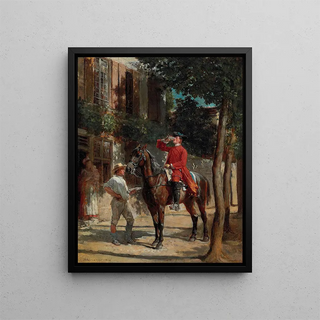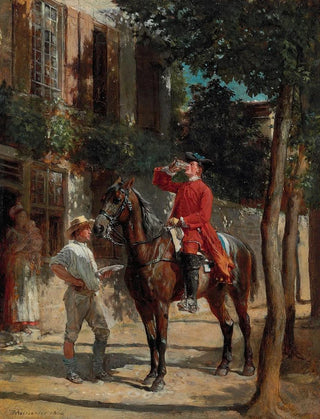Art print La Coupe de l'Étrier - Ernest Meissonier | Art print


View from behind

Frame (optional)
La Coupe de l'Étrier - Ernest Meissonier – Engaging Introduction
In the vibrant universe of art, certain works stand out for their ability to capture suspended moments in time, where emotion and technique blend seamlessly. "La Coupe de l'Étrier" by Ernest Meissonier is one of these masterful pieces. Painted in 1865, this canvas immerses us in a precise moment of military history, revealing not only the artist's virtuosity but also the very essence of the era he depicts. The scene highlights a rider in full preparation, a moment of intense concentration before action. The finesse of the details and the depth of colors invite the viewer to a complete immersion in this painting, where each brushstroke seems to vibrate with its own life.
Style and uniqueness of the work
Ernest Meissonier's work is characterized by striking realism, transcending the simple portrait of a battle scene to create a true visual narrative. "La Coupe de l'Étrier" stands out for its meticulous approach to details, where every element, from the leather of the harness to the rider's expression, is treated with a precision that borders on photographic. Light plays a crucial role in this composition, highlighting textures and creating an atmosphere that is both dynamic and contemplative. Meissonier uses a rich and nuanced color palette, giving his work a rare depth. Mastery of perspective and proportions enhances the sense of movement, making this painting a truly lively scene frozen in a moment of palpable tension.
The artist and his influence
Ernest Meissonier, an emblematic figure of the 19th century, is recognized for his dedication to depicting military life, a subject close to his heart. Born in 1815, he built a reputation through his exceptional talent and ability to capture the spirit of the eras he traversed. Influenced by the masters of the past, Meissonier combined tradition and innovation, creating a style that is uniquely his own. His work not only marked his time but continues to inspire generations of artists. Exploring themes related to war

Matte finish

View from behind

Frame (optional)
La Coupe de l'Étrier - Ernest Meissonier – Engaging Introduction
In the vibrant universe of art, certain works stand out for their ability to capture suspended moments in time, where emotion and technique blend seamlessly. "La Coupe de l'Étrier" by Ernest Meissonier is one of these masterful pieces. Painted in 1865, this canvas immerses us in a precise moment of military history, revealing not only the artist's virtuosity but also the very essence of the era he depicts. The scene highlights a rider in full preparation, a moment of intense concentration before action. The finesse of the details and the depth of colors invite the viewer to a complete immersion in this painting, where each brushstroke seems to vibrate with its own life.
Style and uniqueness of the work
Ernest Meissonier's work is characterized by striking realism, transcending the simple portrait of a battle scene to create a true visual narrative. "La Coupe de l'Étrier" stands out for its meticulous approach to details, where every element, from the leather of the harness to the rider's expression, is treated with a precision that borders on photographic. Light plays a crucial role in this composition, highlighting textures and creating an atmosphere that is both dynamic and contemplative. Meissonier uses a rich and nuanced color palette, giving his work a rare depth. Mastery of perspective and proportions enhances the sense of movement, making this painting a truly lively scene frozen in a moment of palpable tension.
The artist and his influence
Ernest Meissonier, an emblematic figure of the 19th century, is recognized for his dedication to depicting military life, a subject close to his heart. Born in 1815, he built a reputation through his exceptional talent and ability to capture the spirit of the eras he traversed. Influenced by the masters of the past, Meissonier combined tradition and innovation, creating a style that is uniquely his own. His work not only marked his time but continues to inspire generations of artists. Exploring themes related to war
12,34 €






